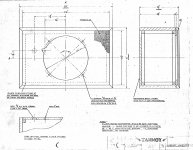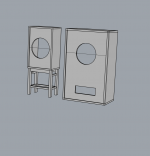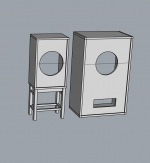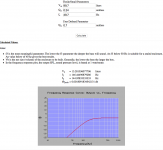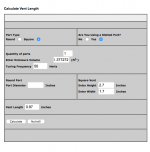Hello,
I was wondering what I loose/gain by building these smaller cabinets ( see attached photo ) compared to bigger cabinets based on original Tannoy plans.
Ref ( comparison ) : http://www.44bx.com/tannoy/images/Lancaster3.gif
TNT ( comparison ) : [DIY project] DIY Tannoy 12" Dual Concentric Horn
INFO:
This IIILZ cabinet will be my speaker cabinet in my second hifi system.
It is needed to be a smaller cabinet, posting because of thoughts of cabinets for the future... and info from other builders that understand cabinets better than myself...
- Is it the bass frequency I will loose compared to Lancaster? This I can live with , but if there are other things I loose I would greatly appreciate an informative answer.
PS: I have already started building the IIILZ cabinets 🙂 - will post pictures when finished !
I was wondering what I loose/gain by building these smaller cabinets ( see attached photo ) compared to bigger cabinets based on original Tannoy plans.
Ref ( comparison ) : http://www.44bx.com/tannoy/images/Lancaster3.gif
TNT ( comparison ) : [DIY project] DIY Tannoy 12" Dual Concentric Horn
INFO:
This IIILZ cabinet will be my speaker cabinet in my second hifi system.
It is needed to be a smaller cabinet, posting because of thoughts of cabinets for the future... and info from other builders that understand cabinets better than myself...
- Is it the bass frequency I will loose compared to Lancaster? This I can live with , but if there are other things I loose I would greatly appreciate an informative answer.
PS: I have already started building the IIILZ cabinets 🙂 - will post pictures when finished !
Attachments
Thank you for your replay; I guess I was more interested in experience/ knowledge about these units/ cabinets from other owners and their experience with these speakers 🙂
We did a small enclosure for a set of Tannoy Gold 12s which worked out well (except held back by the 50ish year old XO)
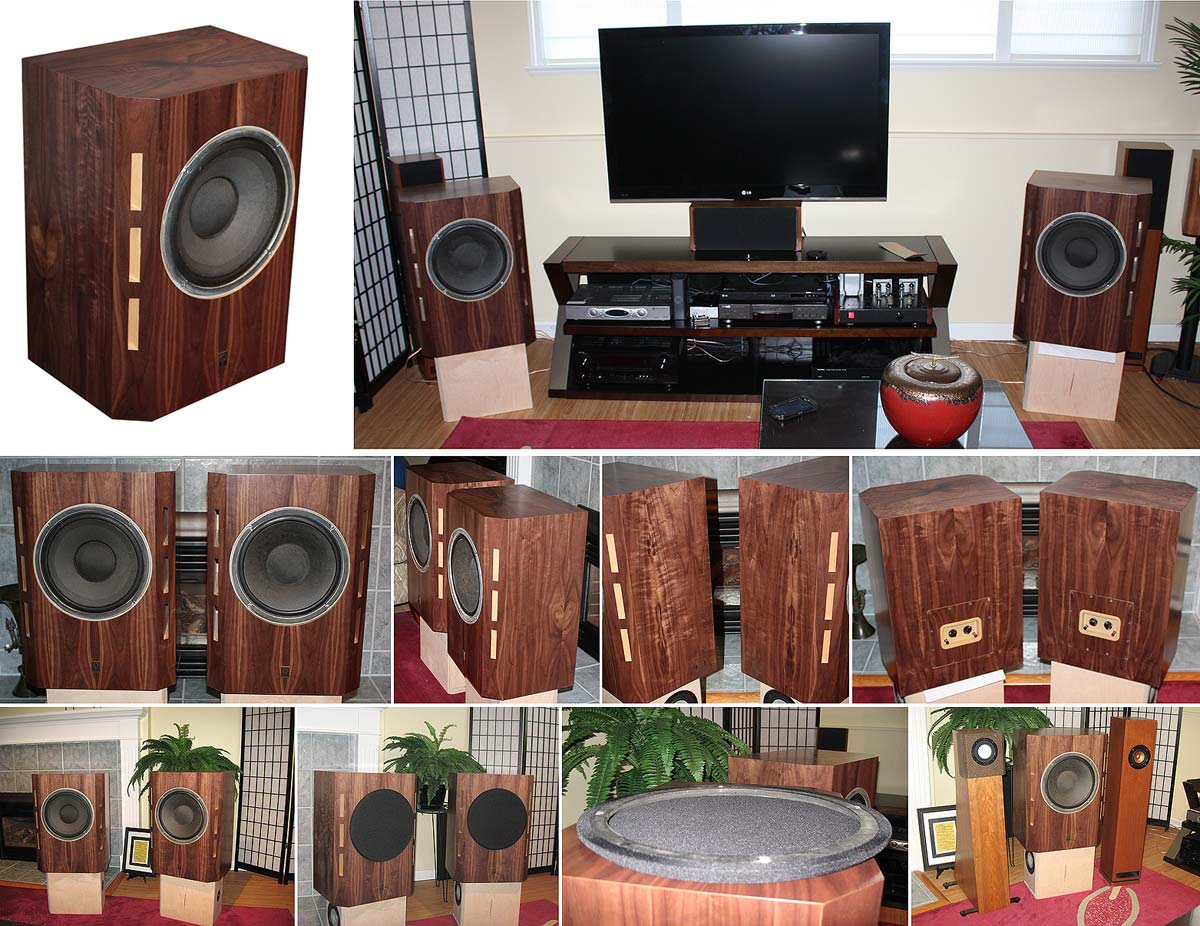
We measured the T/S from the exact drivers on hand and started there.
I expect time & different models will yield different T/S and different boxes.
dave

We measured the T/S from the exact drivers on hand and started there.
I expect time & different models will yield different T/S and different boxes.
dave
Lancaster cabs work surprisingly well in 3/4" ply.. when all is said and done.
Smaller is a waste of a Surprisingly capable driver.
Buy something else if that size is a Necessity in your environment
Note that IS important to have the driver's axis at the proverbial sitting listeners' ear height ~38".
Building a small box that can't do a credible job of sub 200hz..then having to elevate it to get decent soundstaging.. is simply stoopid IMO.
A 150 litres internal volume is a good size for 12's.. Bigger can be even better aledgedly.. at least according to the tannoy designers.
Onken types have proven as Not Great with these... but Hey! take yer pick.
Smaller is a waste of a Surprisingly capable driver.
Buy something else if that size is a Necessity in your environment
Note that IS important to have the driver's axis at the proverbial sitting listeners' ear height ~38".
Building a small box that can't do a credible job of sub 200hz..then having to elevate it to get decent soundstaging.. is simply stoopid IMO.
A 150 litres internal volume is a good size for 12's.. Bigger can be even better aledgedly.. at least according to the tannoy designers.
Onken types have proven as Not Great with these... but Hey! take yer pick.
Last edited:
Hi,
Thanks .
Building my smaller cabs in 3/4" birch ply.
Will not do anything with the original x-overs in the first place
- if I´ll do anything ; I´ll leave the originals as they are , and build new ones based on the old layout / schematics ...
My pick today is the LSU/HF/III cabinet ( on stands )
REF:
Difference on cab size attached ; the LSU/HF/III versus the Lancaster.
PS: I tested one of the drivers yesterday in a LSU/HF/III cabinet - I do really like the sound from these drivers.
Thanks .
Building my smaller cabs in 3/4" birch ply.
Will not do anything with the original x-overs in the first place
- if I´ll do anything ; I´ll leave the originals as they are , and build new ones based on the old layout / schematics ...
My pick today is the LSU/HF/III cabinet ( on stands )
REF:
Difference on cab size attached ; the LSU/HF/III versus the Lancaster.
PS: I tested one of the drivers yesterday in a LSU/HF/III cabinet - I do really like the sound from these drivers.
Attachments
I don't have any 10" or 12" Tannoys. Only 15".
I did my original 15" HPD in a 100litre cabinet based on Tannoy's diy version of the Berkley.
I have since moved to the 200litre cabinet that mimics the Arden.
I wish I had never built the smaller version. The big cabinet is what is right for the 15".
I suspect similar will apply to your 12".
Model it using software you understand.
I did my original 15" HPD in a 100litre cabinet based on Tannoy's diy version of the Berkley.
I have since moved to the 200litre cabinet that mimics the Arden.
I wish I had never built the smaller version. The big cabinet is what is right for the 15".
I suspect similar will apply to your 12".
Model it using software you understand.
AndrewT; I have done some online calculations based on the given T/S parameters from this site: Tannoy Monitor Thiele & Small Parameters
I do not have any windows based computer so I cannot use HornResp
I tried two sites:
Loudspeaker enclosure calculating with Thiele Small parameter
Closed Sealed Speaker Box Software Online Enclosure Design With Frequency Power Graph
AJ screenshot attached in this post with the T/S parameters given.
I think I also now see that these drivers will need large enclosures.
The thing is that I still want/need smaller cabinets; throwing something out there ( as an alternative ) ; Bare; you mentioned that my speaker setup as it was intended by me ( smaller sealed cabs ) will not mange to go below 200 Hz.... what about building dipole subwoofers; a good idea for adding bass in this setup?
a lot of holes in my understanding of this.
for example;
*how to figure out the cutoff frequenzy for the 12" tannoys go in the smaller cabinets I´m building....
*will I manage to build / buy a subwoofer capable of reaching the height of where the Tannoy driver cuts off.
Really appreciated your response so far.
I do not have any windows based computer so I cannot use HornResp
I tried two sites:
Loudspeaker enclosure calculating with Thiele Small parameter
Closed Sealed Speaker Box Software Online Enclosure Design With Frequency Power Graph
AJ screenshot attached in this post with the T/S parameters given.
I think I also now see that these drivers will need large enclosures.
The thing is that I still want/need smaller cabinets; throwing something out there ( as an alternative ) ; Bare; you mentioned that my speaker setup as it was intended by me ( smaller sealed cabs ) will not mange to go below 200 Hz.... what about building dipole subwoofers; a good idea for adding bass in this setup?
a lot of holes in my understanding of this.
for example;
*how to figure out the cutoff frequenzy for the 12" tannoys go in the smaller cabinets I´m building....
*will I manage to build / buy a subwoofer capable of reaching the height of where the Tannoy driver cuts off.
Really appreciated your response so far.
Attachments

I decided to go with the Chevoit plans for my build. Extra braving and all in bamboo ply.
Sounds great. Tight bass control and clear highs. The Mods are the highlight though.
Sent from my iPhone using Tapatalkmmmmmmmm
Box calculators and Tannoys don't usually mix well.
The modelling is fine but the calculators suggestion for 'optimal' is usually anything but ie you end up with a tiny box tuned way high.
For the 12" Monitor Gold with hard-edge surround (Fs 49Hz) the best option I could find quickly was 50L tuned to Fs. This will result in a response that below roughly 200Hz gently drops by 6dB and then remains flat to Fs. This is almost perfectly suited to the once usual amplifier 100Hz bass tone controls but can also be made up by placement using room gain.
The rubber surround version of the 12MG (27Hz) would require about 130L for a similar result in principle but the whole thing is shifted nearly one octave lower.
Tannoy Monitor Gold Crossover: Frequency Response
The modelling is fine but the calculators suggestion for 'optimal' is usually anything but ie you end up with a tiny box tuned way high.
For the 12" Monitor Gold with hard-edge surround (Fs 49Hz) the best option I could find quickly was 50L tuned to Fs. This will result in a response that below roughly 200Hz gently drops by 6dB and then remains flat to Fs. This is almost perfectly suited to the once usual amplifier 100Hz bass tone controls but can also be made up by placement using room gain.
The rubber surround version of the 12MG (27Hz) would require about 130L for a similar result in principle but the whole thing is shifted nearly one octave lower.
Tannoy Monitor Gold Crossover: Frequency Response
Hi !
Thank you for posting 🙂
The cabinets I´m making are 39L
- may I ask what you get out of your program with a 39L cabinet?
- will it still be a smooth roll-off?
PS: I have the 12" Monitor Gold with original surrounds ( textile? )
Thank you for posting 🙂
The cabinets I´m making are 39L
- may I ask what you get out of your program with a 39L cabinet?
- will it still be a smooth roll-off?
PS: I have the 12" Monitor Gold with original surrounds ( textile? )
Still works with 39L.
Tune the port to 50Hz and if your amp has tone controls boost the bass by 3dB and the response should be practically flat to 50.
IME 9 out of 10 controls use shelving filters at 100Hz which is exactly what you want here.
Pretty much all calculators I've tried give the same predictions regarding box tuning, size and modelled response. Where they all seem to vary is the port size and some practical experimentation might be advisable. The important thing is that the unequalized response does not have any humps in it. Humps are bad and make everything much more complicated so best avoided.
Tune the port to 50Hz and if your amp has tone controls boost the bass by 3dB and the response should be practically flat to 50.
IME 9 out of 10 controls use shelving filters at 100Hz which is exactly what you want here.
Pretty much all calculators I've tried give the same predictions regarding box tuning, size and modelled response. Where they all seem to vary is the port size and some practical experimentation might be advisable. The important thing is that the unequalized response does not have any humps in it. Humps are bad and make everything much more complicated so best avoided.
Cool.
- best bet on tuning the bass port?
SMD IM-SG (Impedance Meter / Signal Generator)
PS: got a fully functional Quad 44 with bass tilt.
- best bet on tuning the bass port?
SMD IM-SG (Impedance Meter / Signal Generator)
PS: got a fully functional Quad 44 with bass tilt.
you are mis-using your modelling software.Box calculators and Tannoys don't usually mix well.
The modelling is fine but the calculators suggestion for 'optimal' is usually anything but ie you end up with a tiny box tuned way high....................

I decided to go with the Chevoit plans for my build. Extra braving and all in bamboo ply.
Sounds great. Tight bass control and clear highs. The Mods are the highlight though.
Sent from my iPhone using Tapatalkmmmmmmmm
COOL.
Looks nice !
- how did you get a hold of bamboo plywood?
- can´t get a hold of that where I live ( northern europe ) ; for sure....
PS: Did not see your post until now...
PS: got a fully functional Quad 44 with bass tilt.
That'll do nicely.
Slow grown (Baltic) birch ply is usually considered good enough for the best speaker cabinets.
Only a few went for more exotic materials, like composite panels/aerolam and others.
Only a few went for more exotic materials, like composite panels/aerolam and others.
Thanks 🙂
Charles Darwin:
I found another site where I could calculate vents.
Here: Port Length Calculator
Screenshot from calculations attached
0.97inches= 24/25mm thickness ( that = the thickness of my speaker box )
A square port with the size of 6.9cm ( 2.7inches ) x 4.3cm ( 1.7inches ) like the calculations show ; close enough?
PS: I can install this port at the rear panel right ? - as long as they are freestanding
Charles Darwin:
I found another site where I could calculate vents.
Here: Port Length Calculator
Screenshot from calculations attached
0.97inches= 24/25mm thickness ( that = the thickness of my speaker box )
A square port with the size of 6.9cm ( 2.7inches ) x 4.3cm ( 1.7inches ) like the calculations show ; close enough?
PS: I can install this port at the rear panel right ? - as long as they are freestanding
Attachments
Last edited:
- Home
- Loudspeakers
- Multi-Way
- Tannoy Dual Concentric 12" - Small Cabinet
